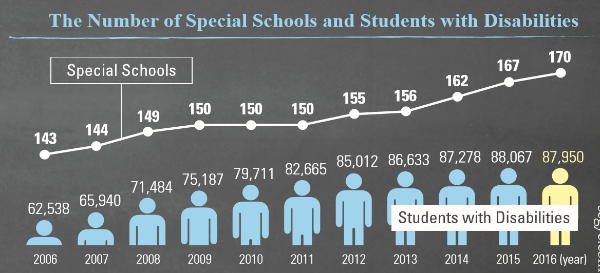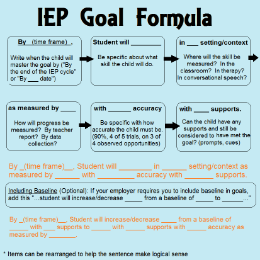A new semester is starting, but not all students are excited on their way to school. A child with disabilities in Seoul has to travel for over one hour every day to get to school. Many applicants for special schools exceed the capacity of school numbers due to a lack of suitable schools, and competition for places has become more intense. Moreover, high school students studying in the courses for vocational training of special schools struggle with the unemployment crisis. The Sungkyun Times (SKT) investigates the current state of establishing a special school, the problems of special education, and domestic and foreign efforts to improve special education.
Current State of Special School Establishment
What Is Special Education?
Special education is a program designed to meet unique educational needs of students with physical, mental, and social disabilities, designed is to help them discover their potential and lead independent lives. Special education is provided by special schools or through special classes in regular schools. Special schools consist of kindergartens, elementary schools, middle schools, and high schools, some of which involve job education.
The Present Situation for Establishing a Special School
•Quantitative Shortage
The number of special schools is insufficient as applicants for schools exceed the number of places available. Students who need special education reached 80,000 in 2016, while those who attended special schools reached just 20,000. Children with disabilities have increased by 40.6% in the past 10 years while special schools increased by 18.9% during the same period. This shortage of schools has triggered entrance refusal. School admission is difficult unless multiple disabilities are apparent in a child, so many children cannot have their educational needs met since it is not easy to judge the degree of disabilities like autism or other developmental disabilities.

•Interregional Imbalance between Supply and Demand
In addition to the general shortage of special schools, interregional imbalance is also a problem. For instance, Ulsan rated the highest number of special schools by 24.4%, and Jeollabuk-do was the lowest at 3.9%. In particular, no special schools were founded in Seoul after 2002. Only 34.7% of children with disabilities in Seoul were able to attend special schools in 2016, and their average commuting time was 30 minutes to 2 hours.
To solve these problems, the Seoul Metropolitan Office of Education made an administrative notice last year that it will establish 3 more special schools before 2019 in Seoul, including Gangseo-gu. Its plan, however, is still controversial because of the difference in stances as seen below.
Dissonance on Establishing Special School
•Against
The Emergency Measures Committee comprised of Gangseo-gu residents is worried about a decline in house prices and what we refer to as ‘Not in My Backyard’ (NIMBY) syndrome. They say Gangseo-gu already has 5 other welfare institutions for persons with disabilities, so building a special school in the same region is against the balanced development of regions. Sung Tae Kim, a local lawmaker, instead suggested the “Substitute Land Proposal.” It proposes that a special school can be made on substitute land, and a site primarily reserved for a special school might be better used as a National Medical Center. His opinion was that the place is inappropriate for people with disabilities because it is a unique site where the birthplace of Heo Jun, the medical scientist of the Joseon Dynasty, is located.
•For
The Central Investment Deliberation Committee of the Ministry of Education judged that the site is suitable for a new school, both financially and geographically. Seoul Metropolitan Office of Education then announced its plan to establish the special school after discussing the accurate budget. Moreover, the Korean Parents’ Network for People with Disabilities (KPNPD) pointed out that the discussion on the special school foundation itself could fall apart if they give up the site, since the current situation cannot even guarantee the substitute land.
Problems of Special Schools
In addition to the establishment of a special school, the school itself has several endemic problems.
Placement of Students with Disabilities
Enrollment of a student with disabilities is often refused due to the lack of special schools, and students cannot study even if they want to. According to 2016 data from the Ministry of Education, 34.7% of children with disabilities attend special schools, and 45.9% attend special classes of regular schools, while 17.2% study in regular classes of regular schools. Furthermore, most Education Offices only examine documents when placing students at high school. Inaccurate and insufficient examinations means that students find it hard to adapt to the educational environment.
Special Education Program
The Ministry of Education and Human Resources Development has set the target rate of vocational education at 50% for special education, but some loopholes lower the educational quality.
•Standardized and Simple Occupational Categories Vocational education is focused on traditional subjects. Representative subjects in documentation of the Presidential Committee on Social Inclusion are: handicrafts, raising animals/plants, embroidery, and knitting. Although some institutions have tried new programs, most of them are still stuck with conventional curriculums.

•Lack of Field Education
About 75% of educational programs are executed in the classroom, dealing with theoretical information which is not related directly with job skill sets. Several schools have programs in industrial sites, but field education is often limited to high school seniors. Moreover, most field education is simple experimental learning, not formal job education. Facilities for regular school activities are also inadequate or inappropriate. Classrooms for crafts or embroidery and knitting, for instance, are worn out. Ways to use the facilities are not even explained in detail. Due to the lack of field education and deficient school activities, only 40% of students with disabilities get a job related to what they learned in high school.
•Problems on Teachers
- Quantitative Limits
According to the Ministry of Education, the average recruitment rate of special education teachers is about 60%, which means 40% of extra teachers are still needed. The recruitment rate of teachers is also unbalanced between regions, as can be seen in Chungcheongbuk-do (48%) and Sejong city (108%). When compared internationally, the number of children with disabilities per 1 special education teacher is 7 in Korea, 3 in the United States (U.S), and less than 2 in Japan. The biggest reason for this shortage is a lack of budget. The budget for special education is decreasing every year, which is partly due to the foundation of private schools not paying money for the support.
- Qualitative Limits
Qualitative limits of teachers come from the difference between special education teachers and vocational training instructors. Special education teachers are literally teachers who help students with disabilities. They do not major in job education. Only 3.2% of the total special education teachers are vocational training instructors according to the Presidential Committee on Social Inclusion, and current job training usually depends on the personal ability of special education teachers. Indeed, teachers with knowledge on vocational rehabilitation can implement vocational counseling or diagnostic assessment, but it is still hard to develop professional skills like gardening or livestock production.
For the Bright Future of Special Education
Improvement Plans for Domestic Special Education
•New and Various Occupational Categories
To escape from the old customs of the existing subjects like horticulture or assembling work, special education needs to be subdivided and personalized based on the individual potential. Possible jobs are all different depending on the disabilities, so educational programs must consider whether students are visually handicapped, hearing-impaired, physically disabled, or have mental retardation. Novel vocational programs receive attention these days like party planning education, and special schools also open promotional booths which display arts and crafts for people without disabilities. These are efforts to reflect the aptitude of students. Gangseo-gu of Seoul, for example, announced that it would launch a program from this year, teaching how to make fragrance diffusers, candles, and coffee depending on each student’s preferences.
•Field Education
Figuring out local communities’ specialties is as important as figuring out students’ personal abilities. Pre-investigation on the local infrastructure is the first step. Schools should be aware of employment information about companies which recruit students with disabilities and support institutions like the Korea Employment Agency for the Disabled. Based on the information about the local society, the next step is to secure industrial sites for job training. Through industrial-educational cooperation, special education must also be done in the field, not only in the classroom. A possible solution is the placement-training model, in which students are taught after the field placement. It might be helpful for students with developmental disabilities who lack generalization strategies, which means that they have difficulties in adapting to jobs if training situations and worksites are different. Working proficiency and consistency, therefore, can be enhanced if students learn ‘in the field’ from the beginning.
•Professional Teachers
Qualitative limits of teachers can be alleviated by lessening the gap between special education teachers and vocational training instructors. One possible solution is to qualify experts in specific areas who have certificates of special education for vocational training instructors. It means opening the opportunities to skilled workers, which can richen job education.
•Reinforcing Rights and Responsibilities of Parents
Most parents of children with disabilities think about their children as those who should be protected for their entire life, not those who can make their own lives. Parents’ roles are important for the independence of students, so special education should include counseling with both students and parents to discuss preferred future careers.
Foreign Special Education

The U.S Individualized Education Plan (IEP) is an exemplary case of desirable special education. Legislation on IEP has been revised every 4-5 years since 1975. It constructs an IEP team for each child, comprised of special education teachers, regular teachers, managers, psychologists, counseling instructors, speech therapists, and occupational therapists. IEP teams cooperate from diagnosing the disability of students to planning individualized educational programs. They regularly measure students’ progress and modify a curriculum if it fails to attain the desired goal.
IEP is connected with “No Child Left Behind (NCLB)”, the legislation to support disadvantaged students. It prioritizes the professional temperament of teachers and scientifically proved instructional methods. It also reinforces rights of parents, making them more active in choices on students’ educational programs. In addition, there is a preventive measure called an early intervention service for children who need extra support, but are not diagnosed as the subject for special education yet. The Local Educational Agency (LEA) is obliged to set 15% of its budget for this service. Lastly, protection of procedural rights is guaranteed through sophisticated steps including prior written notice, due process hearing, and discipline.
The differences between developed and less developed special education result from legislative support, professional management, and individualized strategies. Children with disabilities are not just those who are difficult to handle. They have the same rights for opportunity to get formal and useful education. If the country looks at children with disabilities once more and finds out what we are lacking in comparison to other foreign educational programs, the children of Korea will not have to endure an arduous journey to school each morning.
